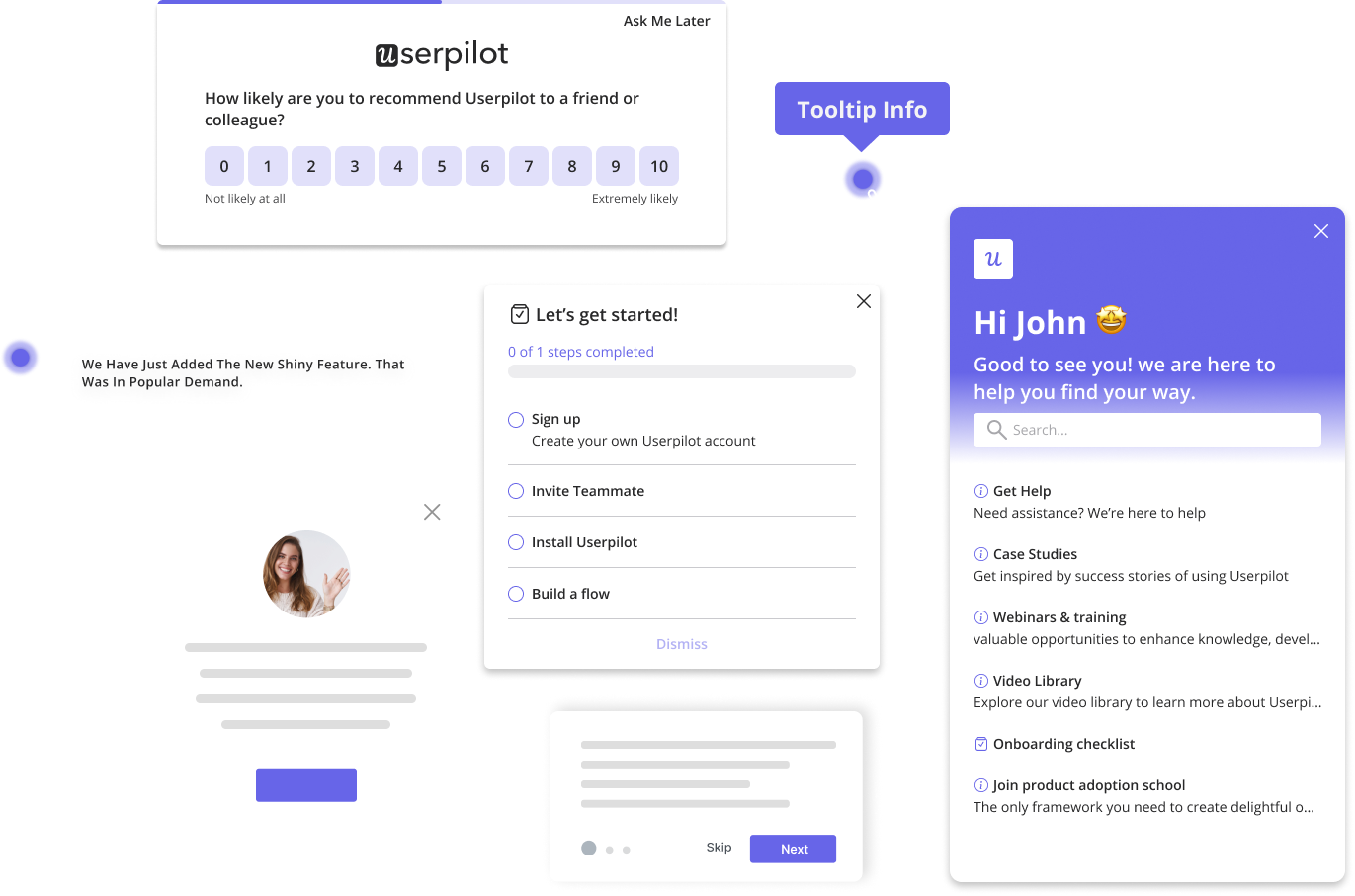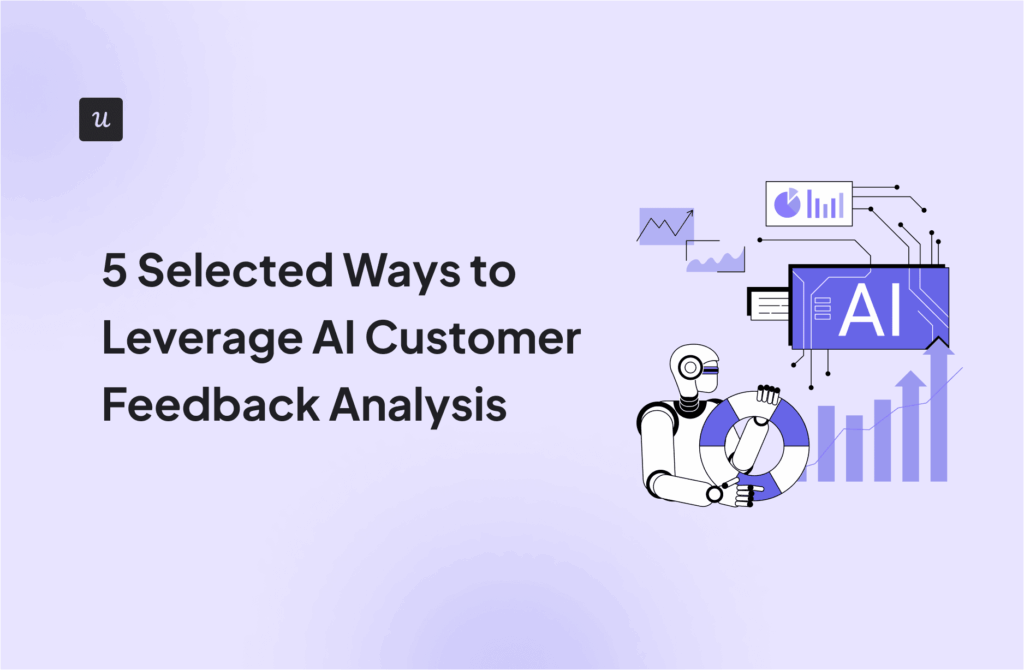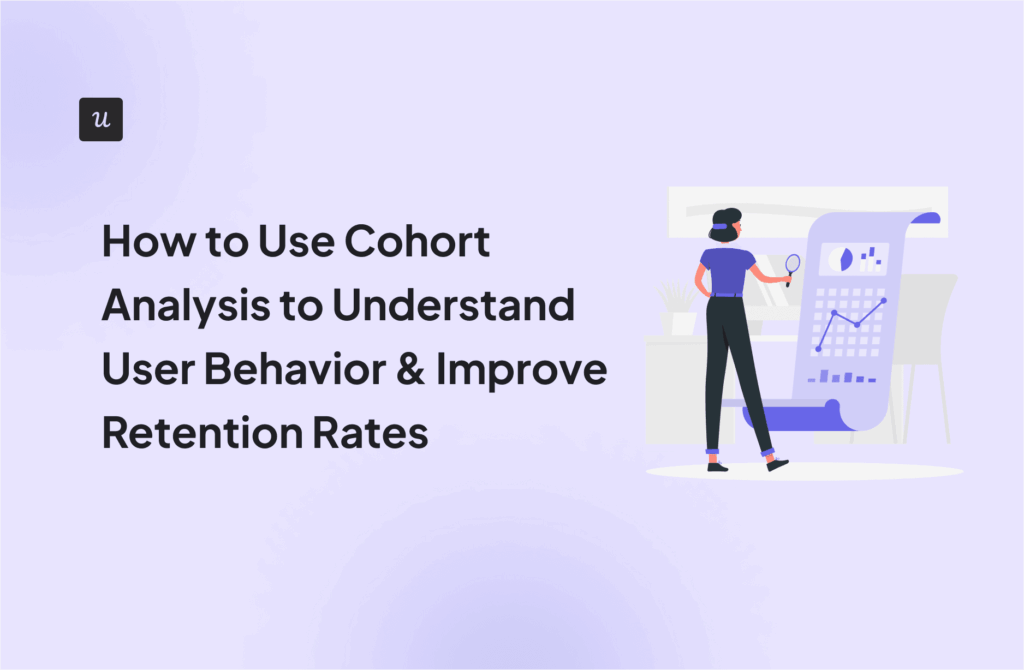![The Complete Guide to AI Customer Feedback [+ 7 How-To Steps for SaaS] cover](https://blog-static.userpilot.com/blog/wp-content/uploads/2025/09/the-complete-guide-to-ai-customer-feedback-7-how-to-steps-for-saas_844e48b93d67a6366faa8dfe6e153030_2000.png)
The Complete Guide to AI Customer Feedback [+ 7 How-To Steps for SaaS]
After analyzing feedback workflows across 1,000+ SaaS teams, we’ve spotted the same expensive pattern: teams collect mountains of customer feedback but act on it too slowly to prevent churn.
Manual feedback analysis is where good product teams go to die. For example, last month, your team spent three weeks tagging 500 responses and concluded ‘users want better onboarding.’ Meanwhile, Sarah from Enterprise Account #47 wrote ‘the export button is broken’ and canceled her subscription while you were still categorizing feedback. The real problem isn’t collecting user feedback; it’s acting on it fast enough to matter.
AI-powered platforms help teams focus on high-impact fixes by processing thousands of responses in minutes, not weeks. Instead of generic themes like “improve UX,” you get specific, detailed insights like “users from trial accounts abandon Feature X after 2 failed attempts because the tooltip is confusing.”
Let’s get into it.
How are you currently analyzing customer feedback?
What’s your biggest challenge with customer feedback?
How quickly can you act on critical feedback (e.g., a bug from a major account)?
You’re losing revenue by not acting on feedback fast enough.
AI customer feedback tools turn insights into action in minutes, not weeks. See how Userpilot can help you prevent churn and drive growth.
Try Userpilot Now
See Why 1,000+ Teams Choose Userpilot
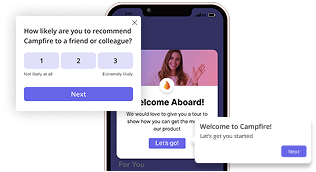
What does “AI customer feedback” mean?
AI customer feedback analysis automatically processes customer input from surveys, reviews, support tickets, and product usage data to generate actionable insights that manual teams miss, aligning closely with customer needs.
Traditional analysis might tell you “users struggle with onboarding.” AI customer feedback analysis tells you “trial users from enterprise accounts abandon the integration setup 73% more often than SMB users, specifically at the API key step.” That’s the level of precision that drives real product decisions.
Unlike manual customer analysis or basic dashboards, AI tools process vast amounts of unstructured data across multiple channels using machine learning models and natural language processing (NLP). They identify patterns in customer sentiment and behavior, then surface trends tied to specific personas or product areas. This allows teams to understand why users say what they say and predict customer satisfaction trends at scale and in real time, leading to more personalized customer experiences.
At Userpilot, our upcoming Product Growth Agent automatically analyzes customer reviews for sentiment shifts, monitors NPS by customer journey stage, and spots top feature requests buried in support conversations. This turns the voice of the customer into specific product decisions and onboarding improvements.
How does AI analyze customer feedback?
AI-powered platforms help teams focus on high-impact fixes by processing thousands of responses in minutes, not weeks. Instead of vague summaries like ‘customers want more features,’ you get detailed insights like ‘enterprise users request single sign-on within 48 hours of their first login attempt.’
1. Collection: Capture customer interactions from every touchpoint
Instead of jumping between tools, AI aggregates raw feedback from structured and unstructured sources across the customer journey:
- Customer surveys triggered by specific user actions.
- Support conversations and live chat transcripts.
- Email replies and CSAT/NPS follow-ups.
- App Store and online reviews from G2 or Capterra.
- Social media posts and forum discussions.
No more blind spots as you see the complete feedback picture, not fragments.
2. Analysis: Turn raw comments into structured insight
Once data is centralized, AI tools apply natural language processing (NLP) and machine learning to enhance predictive analytics :
- Cluster feedback by specific themes like “iOS checkout bugs” instead of generic “payment issues”.
- Analyze customer sentiment to flag experience shifts before they hit your NPS scores.
- Detect anomalies like “enterprise users suddenly complaining about Feature X”.
This results in a clear map of what drives customer behavior, how they feel about specific features, and what’s impacting customer loyalty over time.
3. Action: Feed insights back into the product
The final step is operationalizing those consumer insights:
- Trigger onboarding improvements based on where specific user segments get stuck.
- Prioritize roadmap features tied to revenue-driving feedback clusters.
- Launch targeted in-app messages based on real-time sentiment shifts.
This separates AI feedback tools from traditional analytics. They don’t just inform. They help you act faster, with context.
What are some examples of AI customer feedback in action?
Instead of spending weeks manually analyzing feedback, AI shows you exactly what to fix and for whom. Here’s what that looks like in practice:
- Survey feedback: AI instantly processes thousands of open-text NPS responses and surfaces insights like “Users rating 6 or below mention ‘slow loading’ 4x more than promoters”, not just generic sentiment scores.
- Customer reviews: AI tools analyze customer reviews to detect specific patterns like “iOS users praise the design but Android users consistently mention crashes” across G2, Capterra, and App Store reviews.
- Session replays: AI identifies where users hesitate, rage-click, or abandon tasks, turning hours of footage into actionable insights like “Enterprise users spend 3 minutes confused on the integrations page.”
- Support tickets: Customer conversations get auto-clustered by persona and plan type, revealing patterns like “Startups struggle with API setup” or “Enterprise users request SSO in 73% of upgrade conversations.”
With our Product Growth Agent, teams can go even deeper: Detect anomalies in user behavior and generate breakdowns like ‘Users from Brazil convert 3x more than users from Colombia’ automatically surfaced from dashboard reports and survey responses.
This level of precision helps teams move from cherry-picked anecdotes to data-driven decisions that improve customer experience and reduce churn.
AI-generated “voice of the customer” boards
Traditional feedback reports scatter insights across teams instead of connecting them. Product sees one thing, Support sees another, and Marketing cherry-picks quotes that make them look good. The result? Teams make decisions based on incomplete pictures, while real customer problems get buried in spreadsheets.
AI-generated “voice of the customer” boards solve this by automatically structuring insights by role, goal, and urgency, based on diverse customer interactions. Every team sees what matters most to them instantly. You no longer fight over who owns the feedback process.
Here’s how our Product Growth Agent will make this actionable across your organization:
- Product managers: See feature requests ranked by revenue impact, not just volume. Know that “better search” actually means “search doesn’t show recently edited files” for 67% of power users who mention it.
- Customer success: Get churn risks flagged with context like “Enterprise accounts mentioning ‘slow performance’ are 4x more likely to downgrade within 30 days.” Respond with full background, not generic check-ins.
- Marketing teams: Extract authentic customer language and objections straight from real conversations. Stop guessing at messaging. Use phrases like “finally, something that actually works” because that’s how customers describe your solution.
- Leadership: Spot sentiment shifts before they hit your net promoter score and key metrics. See “satisfaction dropping 15% among Q3 cohort due to onboarding confusion” weeks before it shows up in NPS scores.
No more monthly feedback summaries or insight silos. You get role-specific, real-time intelligence automatically generated from the customer feedback you’re already collecting, turning raw data into decisions that prevent churn and drive growth.
How can AI tools improve customer feedback collection and analysis?
AI transforms customer feedback analysis in ways that go far beyond speed. From faster processing to smarter insights, here’s how AI turns the voice of the customer into decisions that meet customer expectations and reduce churn.
Process feedback in minutes, not weeks
Manual analysis doesn’t scale with success. A team of three can handle 100 responses per week, but what happens when you’re getting 2,000? AI processes unlimited volume simultaneously, surfacing specific insights like ‘trial users abandon the setup wizard at Step 3 because the integration instructions are unclear.’
This speed matters because companies that act on user feedback quickly see measurable improvements in retention. As businesses explore AI agents to accelerate response times, customer comfort levels vary significantly by use case. Nearly half of business buyers (46%) would work with an AI agent for faster service, and 38% of customers are comfortable with agents creating personalized content, while only 17% are comfortable with an agent making financial decisions for them.
Capture feedback across every channel
User feedback comes from everywhere: in-app surveys, support tickets, G2 reviews, and social media mentions. AI tools unify all this feedback data into a single source of truth, revealing patterns like “enterprise users praise the features but consistently mention poor mobile experience.”
Companies that centralize feedback and respond early reduce churn significantly, which helps improve customer satisfaction. In fact, every new dollar spent on AI is projected to generate an additional $4.9 billion in the global economy.
Spot patterns humans would miss
Where humans see noise, AI reveals hidden connections. Machine learning models cluster similar responses, analyze customer sentiment, and surface trends like “users who mention ‘confusing’ are actually struggling with the same three UI elements.”
This precision matters because 82% of customers feel more loyal to companies that improve customer satisfaction through great customer experiences, according to PwC research. AI helps teams focus on high-impact fixes rather than getting bogged down in manual tagging.
Turn feedback into product actions
The real value comes from connecting feedback to user behavior and product decisions, allowing teams to gain deeper insights. AI doesn’t just tell you “customers want better onboarding.” It shows you “SMB users who skip the tutorial are 3x more likely to churn within 14 days” and suggests specific in-app guidance to fix it.
AI-driven personalization strategies are proving highly effective for businesses focused on data-driven decision-making. This shift toward automation resonates particularly well with younger demographics: 77% of consumers aged 18-34 prefer automated solutions for resolving issues or completing tasks, compared to just 40% of those aged 35-44, and only 13% of consumers aged 55-74. This generational divide highlights how consumer expectations are evolving toward speed, simplicity, and self-service capabilities that AI automation delivers.
The 7 steps to use AI customer feedback in SaaS
Most teams collect feedback like they’re hoarding newspapers. These 7 steps show you how to collect less, understand more, and act faster using AI to turn customer noise into customer action.
1. Decide what feedback to collect
Stop surveying everything that moves. Pick one specific question your team needs answered this quarter, then design feedback collection around that single goal.
Focus your collection on specific outcomes:
- Adoption blockers: Ask “What stopped you from completing setup?” when users abandon onboarding after 3 attempts.
- Feature requests: Trigger “What would make you upgrade?” to users hitting plan limits.
- Churn risk: Survey users who haven’t logged in for 7 days with “What’s keeping you from using [product]?”
Userpilot approach: Create targeted surveys triggered by user behavior, not time intervals. Instead of generic email blasts, ask contextual questions when users take specific actions.
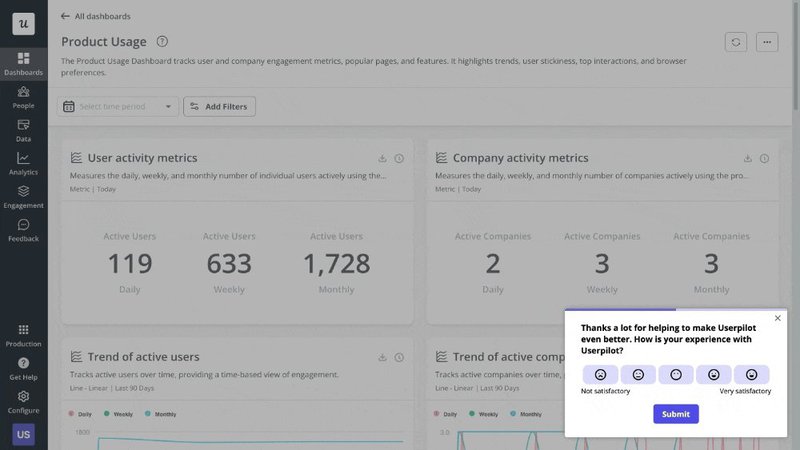
With Userpilot’s Product Growth Agent: Describe your goal in plain language, like “why do trial users churn?” and AI will craft questions, set targeting rules, and eliminate guesswork.
2. Ask better questions, not more questions
Quality beats quantity in survey design. One well-timed question that digs into user motivation trumps five broad questions that confirm your existing assumptions. Open-ended prompts outperform yes/no toggles for understanding what truly drives customer satisfaction.
Userpilot approach: Ask “What’s the biggest blocker you faced during onboarding?” right after users complete (or abandon) setup. Pair open-ended follow-ups with NPS scores to understand why someone gave you a 6 instead of a 9.
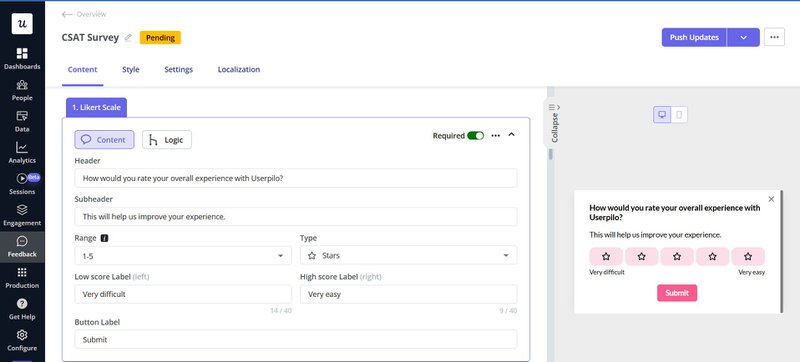
With Userpilot’s Product Growth Agent: Describe the insight you want, like “Find out why enterprise users don’t activate Feature X.” AI will be able to draft specific questions, suggest the right survey type (NPS, CSAT, free-text), and set targeting rules based on user behavior.
3. Centralize feedback from every channel
When your NPS data lives in one tool, support tickets in another, and app reviews somewhere else, you’re flying blind. Centralize everything or stay confused.
Userpilot approach: Collect structured feedback (survey scores, dropdowns) and unstructured feedback (open-text responses) directly in-app. Connect with external tools like Intercom, Segment, and CRMs to import reviews, tickets, and customer data for a holistic understanding.
With Userpilot’s Product Growth Agent: AI Insights aggregates feedback across all channels and auto-clusters responses by theme and segment. Instead of generic categories, you will get specific insights like “Enterprise users struggle with API documentation” or “SMB customers confused by pricing tiers.”
4. Perform customer feedback analysis at scale
Manual tagging is where good insights go to die, underscoring the importance of effective feedback analysis. By the time you’ve categorized 500 responses, the patterns you’re looking for have already changed. AI analyzes responses in real-time and spots connections humans miss.
Userpilot approach: Tag NPS and CSAT responses by theme (onboarding, pricing, feature requests) to track trends over time. Build internal reports and product feedback boards, though manual tagging becomes overwhelming as data grows.
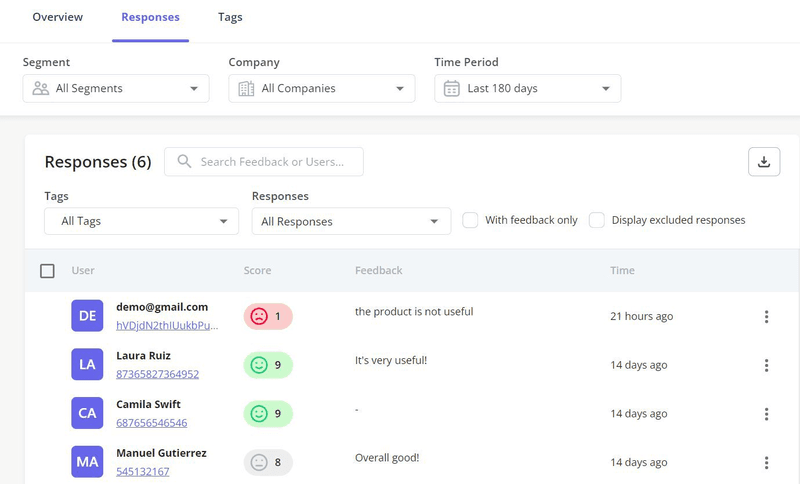
With Userpilot’s Product Growth Agent: Sentiment analysis automatically categorizes responses as positive, neutral, or negative. Auto-clustering will sort feedback into specific categories like “integration setup issues” or “mobile app crashes.” Meanwhile, AI will highlight trends like “negative sentiment around onboarding rising 25% for trial users.
5. Spot anomalies and hidden patterns
Humans spot the obvious, but AI can help identify the underlying pain points. When feedback trickles in across hundreds of touchpoints, the most valuable insights are often the quietest ones.
Userpilot approach: Use manual segmentation to compare customer data across personas, plans, or lifecycle stages. You can identify that trial users rate onboarding lower than paying customers, but only if you already suspect the pattern exists.
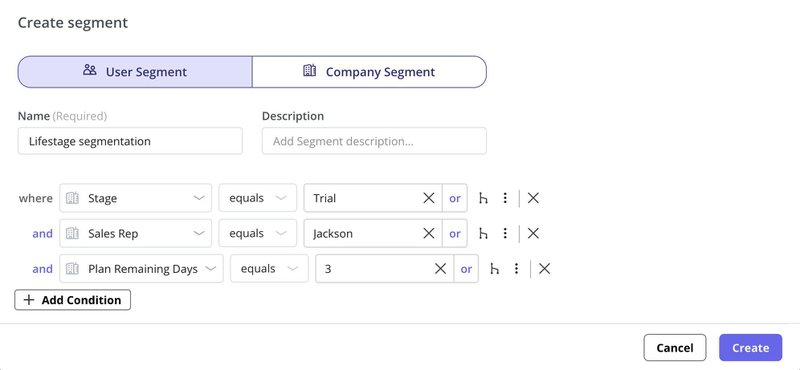
With Userpilot’s Product Growth Agent: It will automatically flag anomalies like “Brazilian users are 3x more likely to complain about onboarding than U.S. users” or “Negative sentiment around pricing spiked 25% since the latest update.” Machine learning correlates sentiment trends with user segments and usage patterns to uncover insights about customer preferences to spot churn risks before they impact your key metrics.
6. Close the loop with customers in real time
Collecting feedback is easy, but acting on it while customers still care is hard. This is where speed wins.
Userpilot approach: Build in-app nudges, banners, and walkthroughs to address pain points directly, enhancing the effectiveness of customer initiatives. Trigger a tooltip explaining a feature if users skip it twice, or show a satisfaction survey right after onboarding completion.
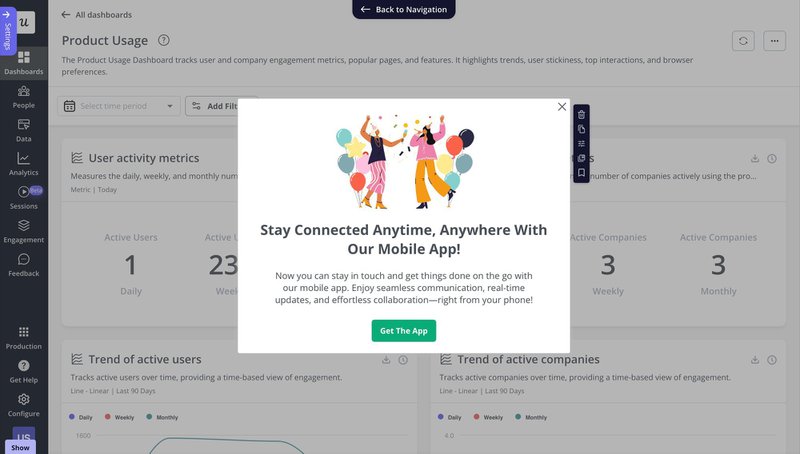
With Userpilot’s Product Growth Agent: Our upcoming Product Growth Agent will auto-trigger playbooks based on detailed feedback and real-time sentiment analysis. If users rate onboarding as “too complex,” the Agent will launch a simplified walkthrough, shorten the customer journey, and alert your product team automatically.
7. Feed insights back into personas and strategy
Feedback should fix bugs, but also inform strategic decisions about how you define your users and guide them across the user journey. Static personas based on assumptions become dynamic profiles based on real behavior.
Userpilot approach: Update user segments manually based on survey inputs like job role and company size, plus behavioral data such as feature usage and session frequency. This provides valuable insights but requires constant manual updates.
With Userpilot’s Product Growth Agent: Machine learning algorithms dynamically refine personas and customer journeys using unstructured feedback. If sentiment analysis shows startup founders care more about pricing than features, AI will automatically shift messaging, onboarding, and nudges accordingly.
How to choose the right AI customer feedback tool?
The right customer feedback tool helps you understand, prioritize, and respond to customer needs in context. Here are five questions to guide your decision:
Ask these five questions:
- Does it collect feedback in the flow of product use? In-app surveys and contextual micro-surveys capture authentic insights better than generic email blasts.
- Can it analyze unstructured responses automatically? Look for tools that use artificial intelligence and NLP to analyze open-text comments, reviews, and support tickets without manual tagging.
- Does it integrate with your product data and personas? Feedback becomes powerful when linked to real user behavior, segments, and lifecycle stages.
- Can it spot anomalies and trends proactively? Great tools detect risks and sentiment shifts before they show up in your metrics.
- Does it help you close the loop with customers? Feedback without follow-up leads to frustration. The best tools help you act on insights in real time.
Userpilot approach: We collect feedback natively inside your product, use AI to auto-tag and cluster responses, sync with product usage data, detect anomalies by persona or plan, and automate in-app responses through playbooks and nudges.
Whether you’re a PM, CS lead, or growth marketer, Userpilot transforms customer feedback into decisions that boost satisfaction and reduce churn.
Your customer feedback loop, evolved
AI feedback analysis helps you act on customer insights while they still matter, ultimately enhancing the overall customer experience.
Stop drowning in feedback and start acting on it. Userpilot AI turns customer input into customer action, helping you identify common complaints and catch customer issues early, fix them fast, and keep users engaged.
Ready to stop reacting to churn and start preventing it? Book a demo to see how Userpilot AI turns customer insights into customer retention.
FAQ
Which AI has feedback connection?
AI-powered platforms designed like Survicate, Qualtrics and with it coming to Userpilot, you’ll be able to connect artificial intelligence directly with customer feedback sources (in-app surveys, reviews, support logs). This way, you can collect, analyze, and turn raw input into actionable insights using NLP and machine learning.
How is AI used in customer support?
AI in customer support automates responses, analyzes sentiment, triages tickets, and detects trends in complaints. This helps teams respond faster, reduce workload, and boost customer satisfaction while understanding customer behavior patterns.
How to analyse customer feedback?
Use AI tools with NLP to analyze customer feedback and extract themes, sentiment, and trends from unstructured data like the voice of the customer. Then visualize valuable insights through dashboards and create workflows that improve customer loyalty.
What is the formula for customer feedback?
Effective customer feedback follows: Feedback = (Right Questions) + (Right Timing) + (Action Taken). AI helps optimize all three by drafting smarter questions, triggering them in context, and turning responses into clear actions that drive business growth.

